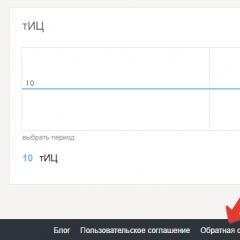How to open registry editor in windows 8.1. How to open the Windows registry: all the ways. How to enter the system registry from the "Run" dialog box
The change in the familiar work environment in Windows 8 and 8.1 has resulted in the fact that some of the actions that were never difficult in Windows 7 and XP began to cause problems for users. So, due to the lack of the usual Start menu, not everyone understands how to open the system registry. However, there are no fewer ways to launch the registry editor in the G8 - there are even more of them than there were in the G7. Here are five of the easiest ones.
Five Ways to Open the Registry Editor in Windows 8
Using the Run app
There are two ways to launch the Run program:
- through the context menu of the Start button in Windows 8.1;

- by pressing the key combination Windows + R.
In the "Open" line of the window that appears, enter the command regedit and click OK.

The result of its execution will be the launch of the registry editor:

Using the command line
In Windows 8.1, Command Prompt is also opened from the context menu of the Start button.

In the console window, enter the already familiar command regedit and press Enter.

The Registry Editor will open.
Via Windows Explorer
You can open the registry editor in the same way as any other program - just by running its file.
From your desktop, open any folder, navigate to the C:Windows directory and double-click on the file regedit.exe.

Through search
You can access Search in Windows 8 and 8.1 from the following locations:
- context menu of the “Start” button (“Find” item);

- the Charms sidebar, which appears on the screen if you move the cursor to the lower or upper right corner and move it a little.

- start screen (magnifying glass icon in the upper right corner).

Enter in the search bar regedit, press Enter and run the found application.

With a shortcut
If you make frequent changes to the registry, you will find it convenient to launch regedit.exe using a shortcut. To create a shortcut on the desktop, enter the directory where the program is located (C:Windows), open the context menu of this file and select the "Create Shortcut" item.

Confirm your consent to place it on your desktop.

Now the registry editor will be launched by double clicking on the shortcut.

Using tiles on the home screen
From the same context menu that we called to create a shortcut, select the “Pin to Start Screen” command.

After that, a regedit.exe tile will be created on the start screen, clicking on which will open the program we need.

Third party programs for working with the registry
There are a lot of applications for editing the system registry. They differ from the built-in regedit utility in Windows 8 with registry optimization functions that are necessary to maintain high system performance. And this is the main purpose of such programs. Let's consider some of them.
Reg Organizer
Reg Organizer is a multifunctional maintenance utility operating system. Allows you to clean and defragment the system registry, manage startup programs, remove applications along with their remnants in the registry and on disks, apply various fine-tuning, etc.
One of the Reg Organizer sections reminds system utility regedit - through it you can edit the registry manually.

This application can be used as a replacement for the built-in Registry Editor, but some of its features, if used incorrectly, can break the functionality of the system and programs. Therefore, Reg Organizer should be recommended only to experienced users.
Registry Booster
Registry Booster is another application that allows you to optimize your system registry for faster startup and Windows work. The program has only three main functions - checking, cleaning and defragmenting the registry, but everything, except for checking, works only after purchasing a license.

Registry Booster is designed for any user, including beginners. Fixes found problems automatically and does not allow you to manage this process manually.
RegScanner
Nir Soft's RegScanner utility is a handy replacement for the built-in registry editor, aimed exclusively at advanced users. Designed to search for data in the registry by a variety of parameters, including the length and date of the last modification. Found entries can be deleted immediately, after making a backup copy of them.

RegScanner is useful for cleaning the system after viral infection and search for leftovers remote programs. Exists in 32- and 64-bit versions. Free.
Registrar Registry Manager
Registrar Registry Manager is an application similar to the built-in Windows Registry Editor, but far beyond its capabilities. It allows you to keep the registry in order on local and remote machines throughout the network. Has functions Reserve copy and restoring data (both individual branches and the entire registry), cleaning, defragmenting, comparing registry keys with each other and monitoring all changes.

Designed for advanced users and system administrators.
The registry is a large database that stores all the settings necessary for the normal operation of the operating system. You can view it through the registry editor, which is available in Windows. Any user can enter it if his account has administrator rights.
And if you made any changes, or the computer turned off by itself, for various reasons, or you accidentally pressed the wrong key and deleted a parameter or an entire registry branch, then this may not have the best effect on the computer.
And yet, if this happened, let's figure out what are the ways to restore the registry of Windows 7 and Windows 8, for the normal operation of the computer.
With a backup
As you probably guessed, this method is not for everyone. If you have previously created backups registry via "File" - "Export" - read on, if not - go to the next method.
So, you have a backup. Press the combination Win + R, the window will open "Run". In the "Open" field, write regedit and click "OK".

The Registry Editor window should appear. In it, go to the "File" tab and select from the menu "Import".

Explorer will open, find the previously created backup in it and click "Open".

Wait while the files are copied.

Using System Restore
A system restore can be done using restore points. You could create them earlier, when the system worked stably and everything suited you. Or they could be created automatically by the system: when making changes to the computer configuration, before installing drivers, and so on.
Let's first consider, how to restore the registry if the operating system boots. In Windows 7, go to "Start" - "Control Panel".

Here we are interested in the point "Recovery".

In the next window, click "Starting System Restore".


Now you need to select a restore point. If there are several points, and you are in doubt, look at the date the point was created - did your computer work normally on these dates ?! - choose it. Clicking "Search for affected programs", you can see which programs will be removed as a result of recovery. Click "Next".

We confirm the rollback of the system to the selected state by clicking "Finish".

All data, including the registry, will correspond to the state that was at the time the selected restore point was created.
If you have Windows 8 installed on your computer, read the article: Windows 8 restore point and system rollback. There you will be interested in the second part. The actions will need to be performed the same as described above.
If the OS does not start
Restore the registry if the computer does not turn on is also possible. In the operating room Windows system 7, when booting up the computer, press, at intervals of 1 second, the F8 button. A window will appear "Additional download options". In it, use the arrows to select the item "Computer Troubleshooting".

In the next window, select a language and click "Next".

Select your account, it is better that it has administrator rights, then enter the password if you have one set when you log in, and click "OK".

The following window should appear, select the item in it "System Restore".

A recovery window will open, click "Next" in it and repeat the steps described in the paragraph above.

If you have Windows 8 installed on your computer, you can press F8 or Shift + F8 when loading, but you are unlikely to see a window for additional download options. It is best to use a system recovery disc or a bootable USB flash drive. You can create them on any other computer with Windows 8 installed.
Follow the link and read the article how to restore Windows 8. Everything is described in detail there. You should have the following window. Then go along the path: "Diagnostics" - "System Restore", and select the desired restore point.

Through the command line
In Windows, the files that are responsible for the operation of the registry are stored in the following path: C: (your system drive letter)/Windows/System32/config . The RegBack folder is also located there, it stores backup copies of all registry branches. They are updated by the system automatically, depending on the settings, every 5-10 days.

We need to do the following: delete the DEFAULT, SAM, SECURITY, SYSTEM, SOFTWARE files that are in the config folder and replace them with similar files from the RegBack folder.
We will not be able to do this in the operating system, since it will be necessary to replace the files responsible for its operation. Therefore, you need to use the advanced boot options, and open the command line.
In Windows 7, press F8 when booting the system. Then you need to do everything as described in the paragraph above. In the window "System Recovery Options", select an item "Command line". As a result, the command prompt will start as an administrator.

In Windows 8, you can open the command prompt using the combination . This is described in detail in the article: Windows 8 Safe Mode. Read the paragraph: enter safe mode using the combination Shift + reboot. When the next window appears, select "Command line".

If the computer does not turn on at all, due to changes in the registry, then read the paragraph: enter safe mode using the system recovery disk (you can create it on any computer with installed Windows 8).
So, we launched the command line. Now enter the following commands line by line. Press "Enter" at the end of each line. First, let's create a badreg folder on the system drive, copy all the files of our non-working registry into it. Then we will safely delete the DEFAULT, SAM, SECURITY, SYSTEM, SOFTWARE files from the config folder, because we have copies of them. And lastly, we copy the backups from the regback folder to the config folder.
MD c:\badreg
copy c:\windows\system32\config\default c:\badreg
copy c:\windows\system32\config\sam c:\badreg
copy c:\windows\system32\config\system c:\badreg
copy c:\windows\system32\config\security c:\badreg
copy c:\windows\system32\config\software c:\badreg
delete c:\windows\system32\config\default
delete c:\windows\system32\config\sam
delete c:\windows\system32\config\system
delete c:\windows\system32\config\security
delete c:\windows\system32\config\software
copy c:\windows\system32\config\regback\default c:\windows\system32\config\
copy c:\windows\system32\config\regback\sam c:\windows\system32\config\
copy c:\windows\system32\config\regback\system c:\windows\system32\config\
copy c:\windows\system32\config\regback\security c:\windows\system32\config\
copy c:\windows\system32\config\regback\software c:\windows\system32\config\
exit
After you enter the exit command, the window command line will close and the computer will restart.
I hope one of the ways will help you restore the registry in the Windows 7 or 8 operating system.
Rate article:
(3
ratings, average: 3,67
out of 5)
Webmaster. Higher education in the specialty "Information Protection". Author of most articles and computer literacy lessons
Similar posts
Discussion: 16 comments
Most likely, you have the DEFAULT, SAM, SECURITY, SYSTEM, SOFTWARE folders in a different path, but not c:\windows\system32\config.
To answer
And what to do?
To answer
You need to find out the path to the specified files. Do you have the 32 bit version installed or the 64 bit version?
I enter commands in the line as shown, for some reason it says: “the system could not find this path”, what should I do?
To answer
Windows 8 is in high demand among PC users. But not everyone knows how to open the registry editor. There are several simple and effective ways to start editing it.
detailed instructions
Option 1
A quick command from the Win + R key combination will open the Run window.
We write the regedit command there and confirm the action with OK.

Option 2
We call the Task Manager with the well-known combination Ctrl + Alt + Del.


At the end of the procedure, we enter the already familiar regedit request and confirm the action.

Option 3
If you hold the mouse cursor on the right side of the screen, the so-called Shutter will drop out, which we need. On it we are looking for the line Search.

Under the Applications item is the Search line, where we write the word regedit.

It remains only to activate the application.

Option 4
In the upper right corner of the My Computer window is the Search line, which we need. There you need to write the regedit command.

Among several shortcuts, you need to select the one that is saved in the C:\Windows directory.

Option 5
Go back to My Computer and open the C drive.


Among the abundance of shortcuts, you need to find regedit with the Application type. Open it by double clicking.

These methods are available in order to visually see how to start the registry. Also, this instruction is suitable for Windows 8.1. Each option only takes a few minutes.
When I hear the phrase Windows registry, I imagine the icon of the regedit.exe program - a semi-disassembled green cube consisting of smaller cubes. What exactly is a registry? I think many Windows users heard about it, but not many have seen and understand what kind of a miracle it is.
The Windows 8 registry is a database that contains settings for the operating system and programs. So, the registry is a database. Like any other database, the registry is stored in files on the hard drive. There are several registry files, the main part is located in the C:\Windows\System32\config folder (%windir%\system32\config). If you look into this folder, then all the files opposite which the “File” type is indicated will be the same registry files.

Another place where registry files are stored is in the root folder of user profiles and along the path C:\Users\\AppData\Local\Microsoft\Windows (%userprofile%\AppData\Local\Microsoft\Windows). Each profile has its own registry files, since for each account uses its own unique hive (section) of the Windows registry, because the settings for all profiles are unique. To open your profile, press the key combination WIN + R, in the window that appears, type %userprofile% and click OK. These files will most likely be hidden from you, you must enable the display of hidden and system files to see them. In the screenshot below, you can see that the registry file is NTUSER.DAT, the rest are logs needed to recover from an unexpected crash.

What do we have at the moment? The Windows 8 registry is stored in files scattered across folders. In order to view or edit some settings of the operating system or programs, you can use the regedit.exe program. It is stored in the C:\Windows folder, but you can run it by pressing WIN+R and typing regedit. In general, Microsoft does not recommend making changes to Windows settings directly through the registry, but using the existing user interface of the operating system. If you run regedit, then I recommend that you do not make any changes, but only familiarize yourself with the structure of the database.

Since all Windows settings are stored in the registry, in the absence of the same user interface(which is typical for truncated Windows versions like Windows 7 Starter), many settings can be changed through the registry. For example, you can use regedit to change the desktop background by specifying your path to the image file, although this cannot be done through the Control Panel.
That's all I would like to tell.



